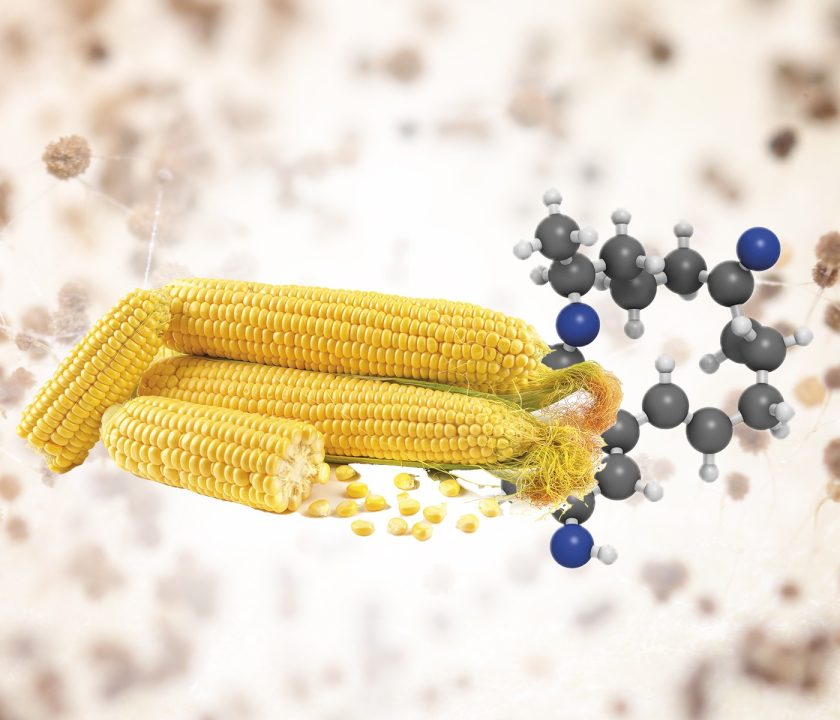Contenido disponible en: Español (Spanish)
Zearalenone (ZEN) is one of the top three mycotoxins contaminating finished feed and grains. Many worldwide reports, from different institutions, indicate that more than half of the samples evaluated show some level of contamination with this toxin.
ZEN has been used as a marker for decades, indicative of the presence of other mycotoxins produced by the genus Fusarium, such as Vomitoxin (DON) and Fumonisin.
- Fungi belonging to the genus Fusarium are very abundant and regularly contaminate growing plants and grains during storage.
- Plants alter the chemical structure of mycotoxins as part of their defense mechanism against xenobiotic substances (foreign to the ecological system where they grow).
- Fusarium graminareum and F. culmorum, besides producing ZEN, also generate DON, which emphasizes the importance of synergism among mycotoxins, once ingested by animals.
- ZEN is heat-stable during storage, grinding, processing, and distribution, and can stand temperatures of 150°C for about 44 hours
ZEARALENONE and its metabolites
ZEN and its metabolites are very potent estrogens, of the non-steroidal type. So far, it is the only mycotoxin identified that causes primary estrogenic effects in animal production, especially in sows and dairy cows.
For more than 50 years, a metabolite of ZEN, called zearalanol, marketed as Zeranol, has been sold in several countries. This is an anabolic agent capable of accelerating body weight gain in weaned calves, steers and animals raised in confinement (feed lots).
Susceptibility
Pigs are considered the most sensitive domestic species, followed by ruminants. Commercial birds are the most resistant. Within this latter group:
- Broilers are the hardiest,
- Turkeys the most susceptible.
- Leghorn (white) layers have proven to be very resistant, in scientific tests conducted with high levels of contamination with ZEN.
Mechanism of absorption and formation of metabolites
Once Zearalenone is ingested, a portion is excreted through urine and feces without absorption through the blood, representing a rapid elimination mechanism.
Another portion of ZEN is rapidly absorbed through the epithelial cells of the small intestine, thereby passing into the bloodstream to subsequently be metabolized in the liver into other metabolites that can be excreted within the:
- intestines,
- via bile and
- then returned to the liver via enterohepatic circulation.
Figure 1. Enterohepatic recirculation system.
Mycotoxins with enterohepatic recirculation are secreted through the bile into the intestinal lumen, increasing their exposure time and once again exerting their toxicity on the epithelial tissue.
In the liver, its transformation occurs because of the enzyme 3 α/β-hydroxysteroid dehydrogenase (3 HSE) convert it into two isomers:
- Alpha zearalenol (α ZAL) and
- Beta zearalenol (β ZAL).
This enzyme causes the hydroxylation of Zearalenone, a process that detoxifies it. As far as estrogenic effects, α ZAL is 500 times more potent than ZEN, while β ZAL is 16 times less potent.
In other words, the production of α ZAL increases the toxicity of ZEN while the production of β ZAL convert it into a less toxic metabolite.
We must emphasize that there are other metabolites of Zearalenone, besides alpha and beta ZAL.
- Metabolically, pigs can transform Zearalenone mostly into β ZAL while chickens can convert it to alpha ZAL, to a greater extent.
- In several scientific studies in pigs treated with ZEN, derivatives of
TO CONTINUE READING REGISTER IT IS COMPLETELY FREE Access to articles in PDF
Keep up to date with our newsletters
Receive the magazine for free in digital version REGISTRATION ACCESS
YOUR ACCOUNT LOGIN Lost your password?

